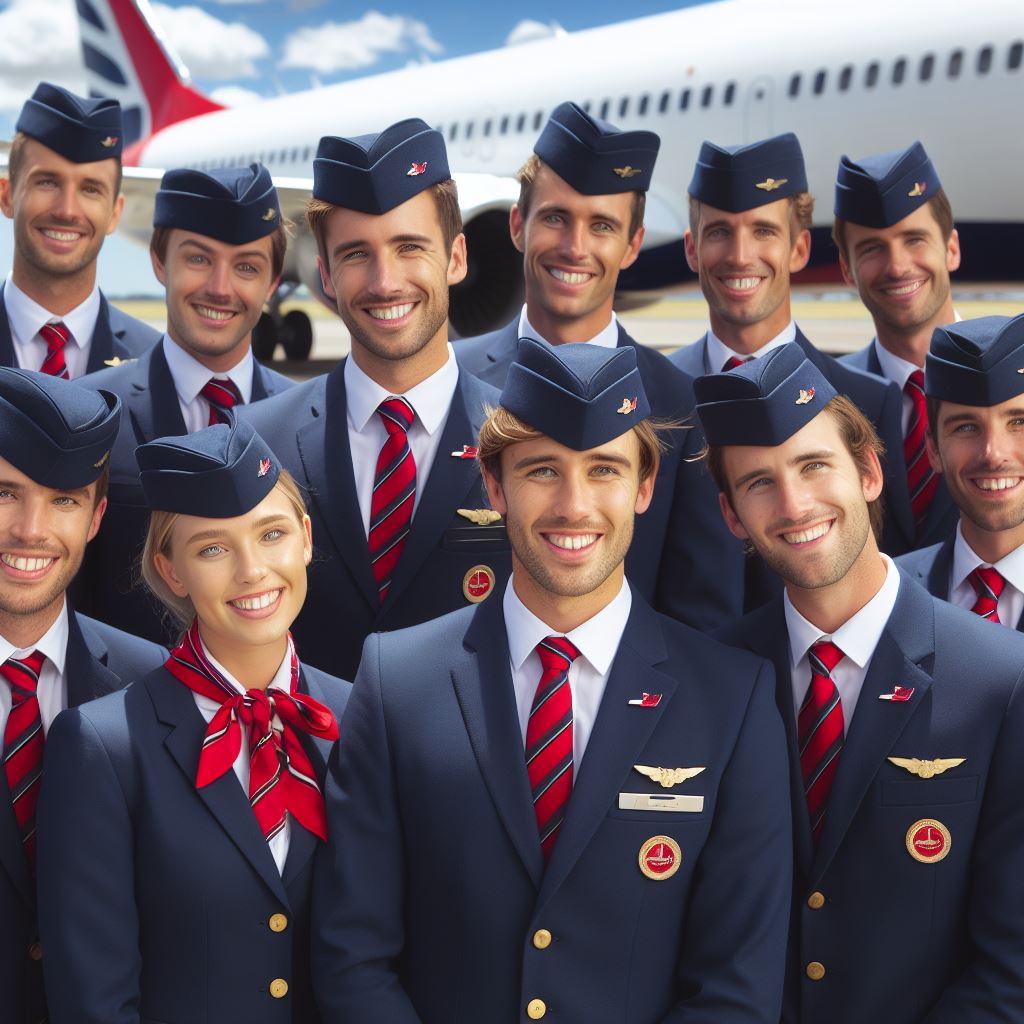Introduction
Flight staff in Australia are integral to ensuring a positive customer experience through cultural etiquette.
This blog will explore the significance of cultural sensitivity for flight staff and examine key considerations.
Understanding and respecting diverse customs significantly enhances passenger satisfaction.
Practical strategies for navigating cultural differences, such as effective communication and accommodating preferences, will be thoroughly discussed.
By prioritizing cultural awareness, flight staff can create a more inclusive and welcoming environment onboard, ultimately contributing to the overall success and reputation of the airline industry in Australia.
Emphasizing cultural sensitivity not only enriches the passenger experience but also reflects positively on the airline, fostering loyalty and attracting a diverse customer base.
Through this blog, flight staff will gain valuable insights and strategies to effectively navigate cultural nuances, thereby enhancing their ability to provide exceptional service to passengers from all backgrounds.
Understanding Cultural Diversity
Airline passengers come from diverse cultures and it is important for flight staff to recognize this.
Flight staff need to be aware of and respect various cultural practices to provide exceptional customer service.
Cultural competency plays a significant role in ensuring the delivery of excellent customer service.
The multicultural nature of airline passengers
- Flight staff should understand that passengers come from different cultural backgrounds.
- Recognizing and appreciating diversity can enhance the overall flight experience.
- This knowledge enables staff to engage and connect with passengers on a deeper level.
- Acknowledging cultural diversity fosters respect and inclusivity among flight crew and passengers.
- Cultural understanding helps create a welcoming and comfortable environment for everyone on board.
The need for flight staff to be aware of and respect different cultural practices
- Flight staff must familiarize themselves with customs, traditions, and protocols from various cultures.
- Understanding cultural practices allows staff to anticipate and address passengers’ needs appropriately.
- Respecting cultural practices demonstrates appreciation for passengers’ values and traditions.
- Misunderstandings arising from cultural differences can be avoided through awareness and respect.
- Knowledge of cultural practices fosters effective communication and reduces the chances of offense or discomfort.
- To provide a positive experience, flight staff should tailor their service based on cultural sensitivities.
The role of cultural competency in providing excellent customer service
- Cultural competency enables flight staff to anticipate and meet passengers’ individual needs.
- It helps flight staff navigate cross-cultural communication and adapt to different customer expectations.
- By being culturally competent, flight staff can resolve conflicts and challenges professionally.
- Improved understanding of cultural nuances enhances the ability to provide personalized assistance.
- Flight staff who are culturally competent can foster positive relationships, leading to customer loyalty and satisfaction.
- Ultimately, cultural competency contributes to an overall positive travel experience for passengers.
Generally, acknowledging and embracing the multicultural nature of airline passengers is essential for flight staff.
Being aware of different cultural practices and possessing cultural competency allows flight staff to provide exceptional customer service.
By understanding cultural diversity and its significance, flight staff can create an inclusive environment on board, anticipate individual needs, and deliver personalized assistance.
Culturally competent flight staff contribute to positive travel experiences and foster customer satisfaction.
Read: Trucking Industry: Australia’s Future
Researching Destination Countries
Fight staff to conduct research on the cultural norms and practices of the countries they will be flying to
Encouraging flight staff to conduct thorough research on the cultural norms and practices of the countries they will be flying to is paramount.
By immersing themselves in the intricacies of different cultures, flight staff can enhance their professionalism and provide exceptional service to passengers.
Resources and tips for gathering information about different cultures
Providing resources and tips for gathering information about different cultures is essential for equipping flight staff with the necessary knowledge to navigate diverse cultural landscapes.
Online resources, cultural sensitivity training sessions, and books on cultural etiquette can offer invaluable insights into the customs, traditions, and social norms of various countries.
The benefits of understanding cultural etiquette for building rapport with customers
Highlighting the benefits of understanding cultural etiquette goes beyond mere professionalism—it is fundamental to building strong rapport with customers.
When flight staff demonstrate an understanding and respect for the cultural practices of their passengers, they create a welcoming and inclusive environment onboard.
This, in turn, fosters positive interactions, enhances customer satisfaction, and promotes loyalty to the airline.
Investing time and effort in researching destination countries’ cultural etiquette is a proactive step toward providing exceptional service as a flight attendant.
It empowers flight staff to navigate cultural differences with confidence, fosters mutual respect between staff and passengers, and ultimately contributes to a more enriching and enjoyable travel experience for all.
Read: Australian Truck Tech: Latest Trends
Dress Code and Appearance
- A professional appearance is crucial for flight staff to convey competence and trustworthiness.
- Flight staff must be aware of cultural differences in dress codes and respect each culture’s norms.
- It is important to research and learn about the appropriate attire for each cultural context.
- When dressing for a Muslim country, female staff should cover their heads and wear modest clothing.
- Flight staff should be mindful of revealing clothing, as it may be considered inappropriate in certain cultures.
- In conservative countries, it is essential for flight staff to dress modestly and avoid exposing too much skin.
- For countries with a more relaxed dress code, flight staff can opt for business casual attire.
- It is advisable to wear traditional attire in countries that appreciate cultural preservation and customs.
- Flight staff should adhere to any specific uniform requirements set by the airline company.
- When uncertain about the appropriate attire, flight staff can consult with local travel authorities or guides for guidance.
Dressing in a professional and culturally appropriate manner is vital for flight staff as they represent the airline company and should demonstrate respect for the diverse cultures they encounter.
By following these guidelines, flight staff can ensure a positive and respectful experience for both themselves and the passengers they serve.
Read: Networking Tips for Logistics Professionals

Greetings and Verbal Communication
Significance of greetings in various cultures
- Greetings play a crucial role in fostering a positive atmosphere and building relationships.
- In many cultures, greetings are seen as a way to show respect and acknowledge the other person.
- Some cultures place great importance on formalities and proper greetings as a way of displaying social etiquette.
- Greetings can also reflect cultural values and norms, such as the emphasis on individualism or collectivism.
- Understanding the significance of greetings is essential for flight staff to create a welcoming environment for passengers.
Examples of common greetings in different countries
- In Australia, a common greeting is a simple “Hello” or “Hi,” followed by a friendly conversation.
- In Japan, people often greet each other with a bow as a sign of respect, accompanied by a verbal greeting.
- In India, a traditional greeting is “Namaste,” where individuals bring their palms together in front of their chest.
- In France, a common greeting is a light handshake with direct eye contact while saying “Bonjour” or “Bonsoir.”
- In China, a common greeting is a nod or bow, with variations in the depth depending on the level of formality.
Cultural variations in verbal communication styles and the importance of adapting
- Cultural differences can greatly influence verbal communication styles, such as directness, tone, and volume.
- In some cultures, directness is valued, and being straightforward is seen as a sign of honesty and clarity.
- In other cultures, indirect communication and reading between the lines are more common.
- Flight staff must adapt to customer preferences by understanding their cultural background and adjusting their communication style accordingly.
- It is crucial to avoid making assumptions or judgments based on cultural differences and instead focus on effective communication.
- Active listening, empathy, and observing non-verbal cues can help flight staff understand and meet customers’ needs.
- Training programs that educate flight staff about various cultural communication styles can be beneficial.
- Being aware of language barriers and providing assistance in a respectful manner can enhance the customer experience.
- Flexibility is key when serving diverse customers, as certain cultural norms may require patience and open-mindedness.
- By adapting to customer preferences, flight staff can not only ensure smooth interactions but also create a positive and inclusive environment.
Read: Managing Fatigue: Tips for Truckers
Non-Verbal Communication
The Significance of Non-Verbal Cues in Cross-Cultural Interactions
Non-verbal cues play a crucial role in cross-cultural interactions, as they can convey meanings and intentions without using words.
These cues include body language, gestures, and eye contact. They are significant because:
- They Express Emotions: Non-verbal cues can communicate emotions such as happiness, sadness, anger, or surprise, which may vary across cultures.
- They Reinforce Verbal Messages: Non-verbal cues can reinforce or contradict what is being said verbally, providing additional context to the message.
- They Establish Rapport: Non-verbal cues help establish trust and rapport between individuals from different cultures by creating a sense of understanding and empathy.
- They Convey Respect: Being aware of and adapting to non-verbal cues shows respect for cultural differences and can prevent misunderstandings or offense.
- They Aid Comprehension: Paying attention to non-verbal cues aids comprehension, especially when there are language barriers or when words alone may not fully convey the intended message.
Differences in Body Language, Gestures, and Eye Contact Across Cultures
Body language, gestures, and eye contact can vary significantly across cultures. Flight staff should be mindful of these differences to avoid miscommunication and promote cultural sensitivity. Here are some examples:
Your Personalized Career Strategy
Unlock your potential with tailored career consulting. Get clear, actionable steps designed for your success. Start now!
Get Started- Body Language: In some cultures, maintaining a close physical distance when interacting is normal, while others prefer a more significant personal space. Awareness of these differences helps flight staff respect passengers’ boundaries.
- Gestures: Hand gestures can have different meanings across cultures. For instance, a thumbs-up gesture is positive in many Western countries but offensive in some parts of the Middle East. Flight staff should be cautious when using gestures to avoid causing offense.
- Eye Contact: Eye contact norms vary greatly. In some cultures, direct eye contact is a sign of respect and attention, while in others, it may be seen as disrespectful or confrontational. Flight staff should be observant of passengers’ comfort levels regarding eye contact.
Navigating Non-Verbal Communication Challenges for Flight Staff
Flight staff can navigate non-verbal communication challenges effectively by following these tips:
- Educate Yourself: Learn about the cultural norms and non-verbal cues of the destinations the airline serves to better understand and appreciate your passengers’ cultural backgrounds.
- Be Observant: Pay attention to passengers’ body language, gestures, and eye contact to gauge their comfort levels and adapt your communication style accordingly.
- Mirror Behavior: When appropriate, mirror the non-verbal cues of your passengers to establish rapport and demonstrate respect for their cultural practices.
- Use Universal Signals: When in doubt, rely on universal non-verbal cues that are generally understood, such as a smile, nod, or handshake, to convey friendliness and openness.
- Seek Clarification: If you are unsure about the meaning of a non-verbal cue or gesture, politely ask for clarification to avoid misinterpretation and possible misunderstandings.
- Emphasize Awareness and Respect: During training sessions, emphasize the importance of being aware of cultural differences and respect for non-verbal cues to all flight staff members.
Basically, non-verbal cues have a significant impact on cross-cultural interactions.
Understanding and effectively navigating these cues can help flight staff promote a more inclusive and culturally sensitive environment for passengers from diverse backgrounds.
By being aware, observant, and adaptable, flight staff can bridge communication gaps and create positive experiences for all travelers.
Dining and Food Etiquette
Importance of Understanding Cultural Dining Norms and Food Preferences
- Understanding cultural dining norms and food preferences is crucial for providing excellent service.
- It shows respect and helps create a positive experience for passengers from diverse backgrounds.
- By following appropriate etiquette, flight staff can avoid unintentional offense or discomfort.
- Knowing the traditions and customs related to dining also enhances the overall professionalism.
Common Dietary Restrictions and Considerations in Different Cultures
- In many cultures, religious or ethical beliefs influence dietary restrictions and food choices.
- Some passengers may follow vegetarian, vegan, or pescatarian diets due to personal or cultural reasons.
- Others might have allergies or intolerances to certain ingredients, such as gluten or lactose.
- Religious observances, such as fasting during Ramadan or avoiding pork in Islam, should be respected.
Guidelines for Flight Staff to Accommodate Diverse Food Preferences
- Communicate with passengers in advance to understand their dietary requirements and preferences.
- Offer a variety of meal options that cater to different dietary needs, including vegetarian and gluten-free choices.
- Provide clear labeling and descriptions of ingredients to assist passengers in making informed food choices.
- Train flight staff on common dietary restrictions and culturally sensitive meal serving techniques.
- hen serving meals, be attentive and responsive to individual requests or modifications.
- Ensure that special meals are properly prepared, stored, and served to avoid cross-contamination.
- Be knowledgeable about food-related cultural customs and rituals, such as not serving alcohol during certain holidays.
- Offer alternatives or suitable substitutes for passengers with restricted diets, ensuring they receive a satisfying meal.
- Maintain a respectful and non-judgmental attitude towards passengers with unique food preferences.
- Encourage a positive dining experience by providing exceptional service and attentiveness to individual needs.
- Remember that food can be an essential part of cultural identity and respecting these differences fosters goodwill.
By following these guidelines, flight staff can create a welcoming atmosphere and ensure that passengers enjoy their dining experience onboard.
Understanding and accommodating diverse food preferences is an important aspect of providing excellent customer service in the airline industry.
Social Customs and Etiquette
Cultural Customs Related to Personal Space, Gender Roles, and Physical Contact
- Understand the concept of personal space and respect cultural variations in its boundaries.
- Be aware of gender roles within different cultural contexts and avoid making assumptions.
- Respect cultural norms regarding physical contact, such as handshakes or avoiding touch altogether.
Appropriate Behavior in Social Settings and Cultural Dos and Don’ts
- Learn about local customs and traditions to avoid unintentionally offending others.
- Follow general etiquette rules, such as using polite language and showing respect to elders.
- Avoid discussing sensitive topics like politics or religion unless initiated by the locals.
- Observe and imitate local behaviors when unsure about appropriate conduct in various situations.
Navigating Social Interactions While Respecting Different Cultural Norms
- Listen actively and be open-minded when engaging in conversations with people from different cultures.
- Show interest in learning about other cultures and ask respectful questions about customs and traditions.
- Be adaptable and willing to adjust your behavior to accommodate cultural differences.
- Respect local customs regarding greetings and use appropriate forms of address.
- Avoid making assumptions about cultural norms and be willing to learn and adjust as needed.
- Be aware of non-verbal cues, such as body language or eye contact, which can vary across cultures.
- Do not force your own cultural practices onto others but instead, embrace diversity and appreciate differences.
- When in doubt, observe and follow the lead of local individuals in social situations.
- Remember that cultural customs are deeply rooted and may not align with your own beliefs or values.
- Recognize that cultural etiquette can differ even within the same country or region.
Handling Cultural Misunderstandings
Acknowledge that cultural misunderstandings can occur despite best intentions
- Accept that despite good intentions, misunderstandings can still arise due to cultural differences.
- Understand that cultural norms and practices may vary widely among passengers and flight staff.
- Recognize that what may be acceptable in one culture might be seen as disrespectful in another.
Strategies for flight staff to handle misunderstandings effectively and ensure customer satisfaction
- Encourage flight staff to foster open communication and active listening when interacting with passengers.
- Train flight staff to be culturally sensitive and aware of potential cultural differences that may arise.
- Offer guidelines on how to politely inquire about customs or practices without causing offense.
- Encourage flight staff to remain calm and patient when faced with misunderstandings and conflicts.
- Emphasize the importance of problem-solving and finding mutually agreeable solutions for all parties involved.
Encourage open-mindedness, empathy, and willingness to learn from each cross-cultural experience
- Promote a culture of learning and curiosity about different cultures among flight staff.
- Encourage flight staff to take the time to educate themselves about the cultures they may encounter.
- Foster an environment where flight staff feel comfortable asking questions and seeking clarification.
- Highlight the benefits of cultural diversity and the enriching experiences it can bring to both staff and passengers.
- Support initiatives that promote cultural awareness and understanding, such as cultural training programs.
Therefore, handling cultural misunderstandings is an important aspect of providing excellent customer service in a cross-cultural setting.
By acknowledging the possibility of misunderstandings, providing effective strategies for handling them, and promoting open-mindedness and empathy, flight staff can ensure customer satisfaction and create a respectful and inclusive environment for all passengers.
Conclusion
In closing, cultural etiquette holds immense significance in the aviation industry, particularly for flight staff tasked with ensuring passenger comfort and satisfaction.
Understanding and respecting diverse cultures encountered during flights is essential.
By embracing cultural diversity and striving for cultural competence, flight staff can cultivate a welcoming and inclusive environment for all passengers.
This, in turn, positively impacts customer satisfaction and the overall flight experience.
When passengers feel respected and understood, they are more likely to have a pleasant journey and become loyal customers.
Therefore, ongoing education about different cultures, customs, and practices is paramount for flight staff.
By continually expanding their knowledge and awareness, flight staff can provide the best possible service to passengers from diverse backgrounds.
Recognizing and celebrating cultural differences not only fosters stronger connections with passengers but also promotes a positive image of the airline and contributes to the success of the aviation industry as a whole.




